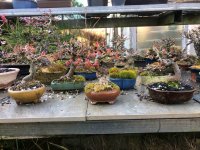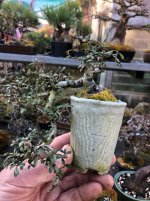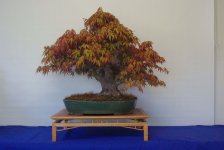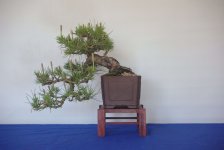@Attmos and others new to the hobby. There are no stupid questions. Asking soil questions is important, and the answer that "only akadama will do" is not good enough. You need to understand the interplay between your soil components, your irrigation water chemistry, water frequency, and your fertilizer. This is a complex interaction, not easy to fully grasp in a few short posts.
I started learning about bonsai when I was only 15, in 1970, at that time in USA the few books available recommended crushed granite and garden soil as potting mix. It was not until the middle or late 1980's that better translations of Japanese bonsai books, and Japanese trained teachers like Bill Valavanis began explaining the horticulture related to bonsai, I forget when Akadama became available in the mid-west. I know it was available first on the west coast, then followed by east coast and thru Valavanis' nursery. Now I can pick it up at Hidden Gardens in Willowbrook IL, a mere hour drive from my home.
I also was deep into orchid horticulture through my many years of learning bonsai. One thing I can tell you, you can grow an orchid or a tree in just about any media if you really understand how to water the mix correctly. I've grown a few orchids in rubber tire chips, just to prove this point. I switched back to my "regular" fir bark based orchid mix, But the point was made. An ash tree and a black locust seedling sprouted in different pots of my rubber tire orchids, and they grew well.
Skipping 40 years to present,
Now imported Akadama and Kanuma are widely available, and a blend of pumice and or lava (scoria) is one of the most often recommended mixes. Others still commonly used components are fir bark, perlite, diatomaceous earth if you can find the right particle size. Somewhat out of fashion, but actually okay if in quantities less than 25% of the total mix, Turface and other calcined clay products. There are problems with calcined clay products, see the many threads on specific brand names. But generally if the percentage of calcined clay is less than 25% of the total volume of the mix, most don't have problems.
Perlite is heated and expanded obsidian, at least 75% silicon dioxide, essentially volcanic glass. Perlite is very light weight, which in bonsai pots can be a problem, Without another component perlite will allow the tree to shift around too much. But in its favor, perlite is widely available in different particle sizes and cheap enough. Dry perlite will float on water. A covering of moss over the media will help hold the perlite in place.
Pumice is another mined volcanic product, Here the silica dioxide content can vary more, from as high as 75% down to less than 50%. Pumice can chemically be from Rhyolite (high silica) through Dacite (intermediate silica) through basalt (relatively low silica dioxide, around 50%) Pumice is defined mainly by its bubble (vesicle) size and thickness of the walls between the vesicles. Pumice may or may not float on water. Most I've purchased usually sinks.
Lava (scoria) is same chemically as Pumice but with fewer, more coarse vesicles and and a greater density. There is a wide range of color for lava depending on source, from gray to red to black.
East of the Mississippi, most of the perlite and pumice comes from quarries in New Mexico, from ignimbrite deposits from El Valle caldera and other New Mexico volcanoes.
Pumice can be used as 100% for junipers, and mixed down to any % desired for other species. I have had junipers go 10 years in pumice without the pumice deteriorating. I tend to use liquid fertilizers, so there is little "clogging up" of the mix from debris of solid fertilizer. If you use rapeseed cake or other pellet or cake fertilizers, you might have to repot more often than once every 10 years.










